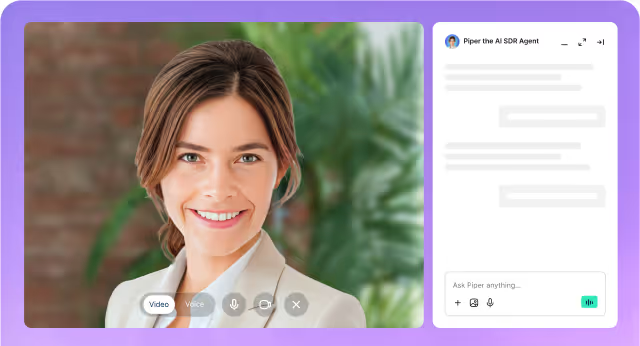Connecting Qualified to Marketing Cloud Account Engagement (formerly Pardot) is a fantastic way to supercharge your pipeline generation efforts. By linking the two systems, Piper the AI SDR agent can leverage rich data from both platforms to have more intelligent, contextual interactions with your target buyers.
Note: Salesforce has rebranded Pardot to Marketing Cloud Account Engagement. To keep things clear as you work between our guide and our app, please note:
-
In this Article: We refer to the platform as Account Engagement (Pardot).
-
In the Qualified App: You will see the original name, Pardot, used for all labels, buttons, and menu items.
Prerequisites: Preparing Your Integration Users
Before you can connect the two platforms, you need to ensure you have the correct user credentials ready in both Salesforce and Account Engagement.
-
A Dedicated Salesforce User: You will need a Salesforce user to authenticate the connection. We recommend using a dedicated integration user for this purpose.
-
An Account Engagement (Pardot) User: You will also need an Account Engagement user with an Administrator role.
-
The Critical Link: The most important step is to ensure your Account Engagement user is linked to your Salesforce integration user and that Salesforce Single Sign-On (SSO) is enabled. Regardless of whether your company uses Salesforce User Sync or creates users directly in Account Engagement, this SSO link is what allows the platforms to communicate and is essential for the integration to work.
If you need to create a new user in Account Engagement, you can follow the instructions in this Salesforce article: Create Account Engagement Users. Please consult your Salesforce Administrator for assistance with creating or confirming the Salesforce integration user.
Once you have confirmed that both users exist and are properly connected via SSO, you can proceed with the steps below.
Step 1: Find Your Business Unit ID
You'll need this 18-digit ID to tell Qualified which Account Engagement instance to connect to.
-
In Salesforce, navigate to Setup or Marketing Setup.
-
Use the Quick Find box to search "Business Unit" and select Business Unit Setup.
-
From the Business Unit Setup page, copy the 18-digit Business Unit ID. You'll need this in the next step.
Step 2: Establish the Connection in Qualified
Now you'll use the credentials and ID you prepared to make the final connection.
-
As a Qualified Admin, navigate to Settings → Integrations → Pardot → Connection.
-
In the Connection tab, click Connect to Pardot.
-
Paste the Pardot Business Unit ID you copied from Salesforce.
-
Click Connect. You will be redirected to a Salesforce login screen.
-
Enter the username and password for the dedicated Salesforce integration user you prepared earlier.
-
Note: you may need to click "Use Custom Domain" before entering your credentials to properly authenticate.
-
-
Click Allow to grant Qualified the necessary permissions to complete the connection.
And that's it! Your Qualified and Account Engagement (Pardot) platforms should now be connected.
Step 3: Configure Your Integration Settings
With Account Engagement (Pardot) connected, let's configure your settings to ensure you're tracking every key interaction and identifying known prospects on your site. This process has two main parts: first identifying prospects, and second, logging their activity history.
Set Up Prospect Identification & Activity Tracking
Part 1: Set Up Prospect Identification
First, you'll need to create a new piece of Dynamic Content within Account Engagement. This step allows Qualified to identify known Pardot prospects the moment they arrive on your site. For general instructions on how this feature works, you can reference the official Salesforce documentation on how to Create Dynamic Content.
The steps below provide the specific configuration required for the integration with Qualified to work properly.
-
In Account Engagement (Pardot), navigate to Content → Dynamic Content and click + Add Dynamic Content.
-
Name the new content:
Qualified for Pardot - Dynamic Content. You can save it in any folder that makes sense for your team. -
In the Default Content field, paste the following code block:
*QUALIFIED*%%email%%*QUALIFIED*-
Important Note for HML Users: If your Account Engagement account has been upgraded to use Handlebars Merge Language (HML), you must replace
%%email%%in the script above with{{Recipient.Email}}.
-
-
On the right side of the editor, find the default "Variation" that Account Engagement may have added. Click the gear icon and Remove it. You only need the Default Content for this to work.
-
Click Save.
-
Return to Qualified, navigate to Settings → Integrations → Pardot → Connection, and click the Verify Prospect Tracking button to ensure the setup is successful.
Part 2: Set Up Engagement History Tracking
This step uses a dedicated form to log every conversation as an activity on the prospect record.
First, you will need to create a new form in Account Engagement (Pardot). For general instructions, you can reference the official Salesforce documentation.
While creating the form, please ensure you follow these specific configuration steps required for the Qualified integration:
-
Name the form exactly:
Conversation via Qualified. -
On the 'Fields' step, delete all fields except for Email. This is crucial for the integration to work correctly.
-
Proceed through the remaining setup steps using your standard layout template and then Confirm & Save the form.
-
Return to the Pardot settings page in Qualified (Settings → Integrations → Pardot → Connection).
-
Scroll down and click the Verify Activity/Engagement History Setup button to confirm the connection.
Configure Other Settings
-
Default Push Destination: Set Pardot as your default destination to ensure that when reps "pounce" on anonymous visitors, they can effortlessly create new or update existing prospects in Pardot.
-
Custom Prospect Fields: When you add or change prospect fields in Pardot, click the Update fields button here to sync those changes into Qualified, making them available in the Visitor 360.






.svg)


